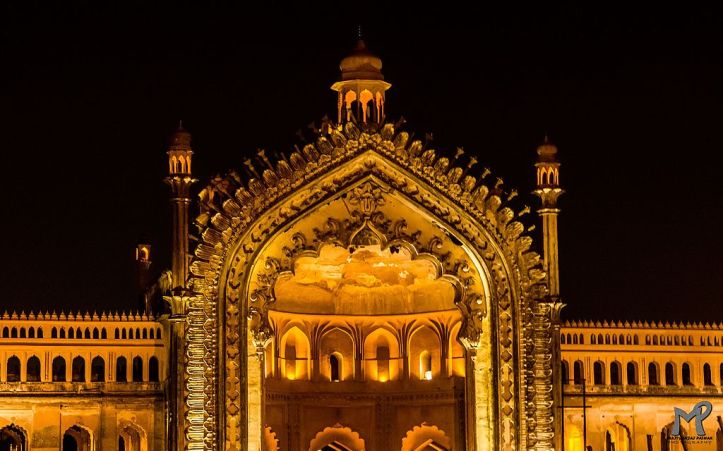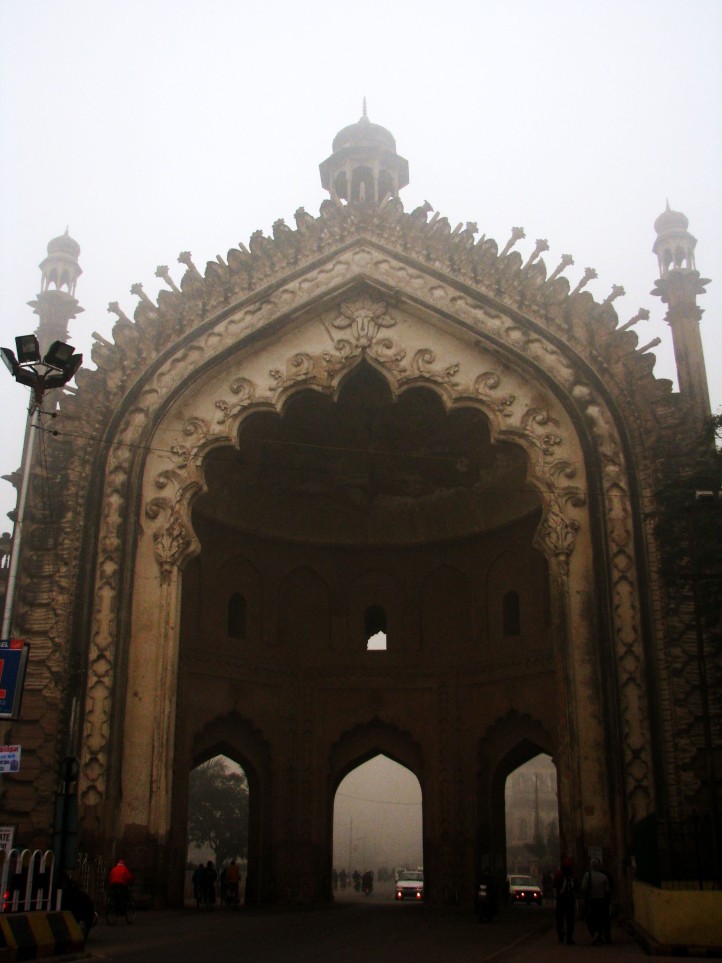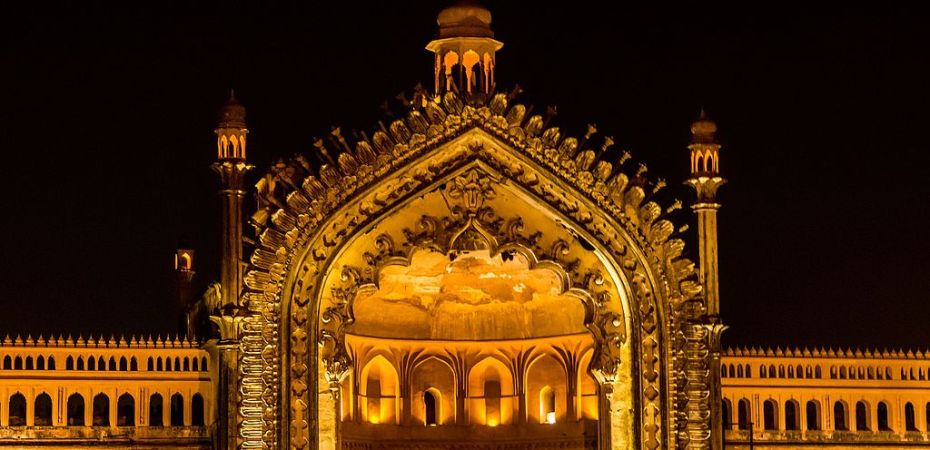Monumental Gates has always been a reflection of prosperity for Kingdoms. Rulers, over the course of human civilisation, have always wanted to build gigantic gates which will play a pivotal role in the security of the countrymen and also display the might of the state. Not only for military reasons, many gates have been erected to display joy, honour and in good gesture. ‘Gates’ have remained a very important component of Architecture in the country. All these mighty gates carry unforgettable legacy and history. In this Journey, I will be travelling through all those famous or infamous gates of India which have played important roles in the History of the Great Nation.

In my last instalment of this series, I mentioned about a memorable quote by the Urdu poet Shamsur Rahman Faruqi where he described the Rumi Darwaja as the Diadem of a Queen. Truly – The Rumi Darwaza of Lucknow is the most beautiful gate in the country.
- Located at: Lucknow, Uttar Pradesh
- Built Between: 1784
- Height: 20 Mtrs
- Architectural Style: Turkish mix of Indian Architecture
- Architect: Unknown (Built under supervision of Nawab Asaf-ud-Daula)

‘Rumi’ was colloquially used to mention something that has a Roman connection. The Nawabs of Awadh were Turkish Shia Muslims who came to India in the 16th Century. Their connection with Istanbul, which was the capital of Eastern Roman Empire, has reflected in their art & architecture. Rumi Darwaza is one such magnificent piece of architecture which is a perfect blend of Indian and Turkish Architecture.
After Nawab Asaf-ud-Daula shifted his capital from Faizabad to Lucknow (Lucknow: The City of Heritage & Culture – A Walk Through History), his state faced a severe famine. Awadh, which was the biggest producer of grains in the entire Mughal empire faced such a natural disaster that the population went to starvation. The Nawab, from his royal treasury, offered relief to the people but the dignified population denied that. The Nawab, with his prime minister Hasan Raza & Diwan Raja Tikait Rai, formed Rifah-e-aam, a charitable institution which would construct buildings, bridges, lakes, dams, wells and engage the citizen as workers. That was the period when most of Lucknow’s architectural gems including the entire Bara Imambara Complex (Asafi Imambara, Asafi Masjid & the Shahi Bawli) and their main entrance Rumi Darwaza were constructed. (Shaam-e-Awadh: A Visual Journey of Lucknow
)

The gate is unique because of its architectural distinction from all other in the country. In the plan, the gateway is a semi-octagonal structure with a dome roof. The gateway is located in the centre of a 2-storied U-shaped building with several rooms inside. This was meant for the security personnel guarding the Imambara complex.
From the front, the gateway is a giant cusped archway with two level of arches inside. The lower tier has the bigger ones – again cusped arched and are the actual gateway. The smaller ones in the upper tier are actually windows used for security reason. The building on both sides of the main gateway is pierced by series of cusped arches. On the outermost surface a very interesting pattern created by using three recessing arches and extensive floral pattern on those. The outermost of these arches is clad with lotus petal design which protrudes out of the masonry to create an amazing skyline. This level is also decorated with floral turrets and that surely makes it look like the crown of the queen.

The next two series of arches are clad with rounded beads and floral pattern. On two sides of the main gateway, two octagonal minarets with chhatris as high as the gateway are created. The chhatris have a connection with the Mughal & Indian architecture. The most fascinating element of this gate is its octagonal arched cupola with a traditional chhatri on top. This was used a lantern during the night and once lit, it illuminated the entire gate making it appear as the gateway to heaven.

Contrary to its front, the back of the gate is very simple – may be reflecting how art has to be created in the time of crisis. The back of the gate is rectangular with the three main arched gates and smaller cusped arched windows in the top. The roof of the gate is decorated with low curtain wall parapet with a row of small chhatris.
The gate along with the other buildings built in the same period have a very interesting architectural feature and that is its material. while the Mughals were extensively using expensive stones at that time, the state of Awadh did not have money for that. Moreover, they had to find a method of construction that their farmer citizen can learn quickly. So they started these buildings with burnt brick & mortar. The red low bricks called Lakhauri were made locally with clay. The entire Rumi Darwaza is constructed with mainly two sizes of bricks – 100mmX150mmX20mm & 100mmX150mmX50mm. The low height of 20mm & 50mm allowed the masons give excellent shape to the buildings and curves. Lime crushed with brick was used as mortar – generally of 20mm thickness horizontally & 10mm thickness vertically. The mortar called Surkhi was prepared by mixing locally available crushed lime with crushed Lakhauri and water. It had extremely high bonding quality.

Rumi Darwaza, one of the marvels in Architecture in India, stands high for more than two centuries witnessing the War of Independence, the fall of the Nawabs and the rule of the British. The excellent piece of art is truly a unique identity of the city of Lucknow.
Best time to Visit: The gate is always open and used.
How to reach: Auto is the best medium to reach and is always available from all parts of the city.
![]()




Beautiful clicks…u always come up with an awesome info ✌✌
LikeLiked by 1 person
🙂
LikeLike
Very enlightening and great photography. The depth of your knowledge is very apparent. Thanks for sharing this!
LikeLiked by 1 person
Interesting architectural style. It could be something normal for India, but for me, in Europe, it looks very exotic.
LikeLiked by 1 person
I love gates! They signify openness, movement, and change. Also, transformation! All these gates remind me of my first visit to Mumbai when I saw Gateway of India.
LikeLiked by 1 person
As an architecture and history lover, I’m fascinated by this structure. And more so, by the extensive details describing this unusual structure in this blog post. We are planning a road trip from Delhi to Lucknow soon and will explore the historic city then 🙂
LikeLiked by 1 person
👍
LikeLike
These gates are extraordinary and certainly cannot be seen in any other places. The unique structure and intricate details are worth paying a visit. 🙂
LikeLiked by 1 person
Rumi Darwaza is indeed magnificent, and your writing does justice to its beauty. One of my favorite memories of Lucknow is passing under the Rumi Darwaza in a cycle rickshaw and taking in its grandeur.
LikeLiked by 1 person
Astonishing gates! Love this picture! Would love reading your thoughts on my latest blog post here: http://thisissivylla.com/2017/12/christmas-hair-make-guide/
Love,
Sivylla
LikeLiked by 1 person
That’s interesting! To actually read in detail about a gate is not common! Glad to go through your post on Rumi Darwaza. Hope I’ll visit Lucknow soon and see this with my own eyes!
LikeLiked by 1 person
Wow! These are so beautiful! And such great information! I would love to be able to see these in person!
LikeLiked by 1 person
These gates are so remarkable and outstanding. Rumi Darwaza is so astonishing and I would love to see it in person! 😉
LikeLiked by 1 person
Thanks a lot
LikeLike
[…] journey through the Greatest Gates of this country now brings me to the capital – the city with the richest history. Delhi has seen as many as […]
LikeLiked by 1 person
[…] some of the most historic gates in the country. So far I have been mostly covering gates built in Islamic or Post Islamic period in the country. This somehow is making it a more or less monotonous journey. […]
LikeLike
Amazing architecture and the history was well-recapped if I may say so!
LikeLiked by 1 person
[…] […]
LikeLike
[…] […]
LikeLike